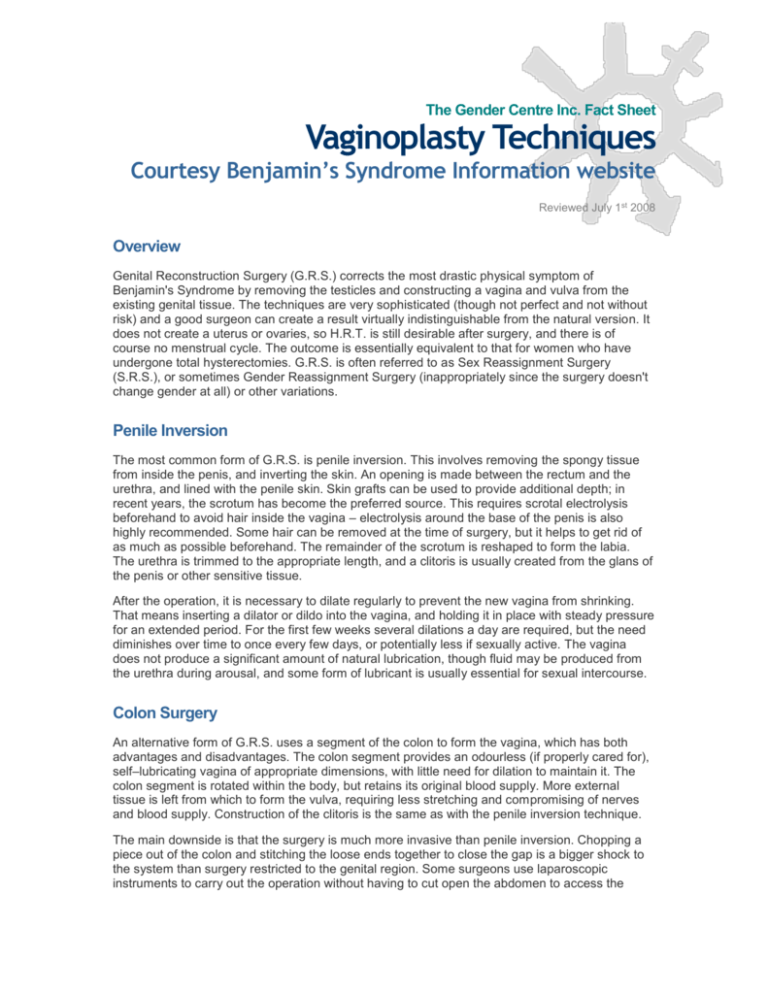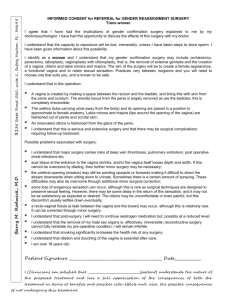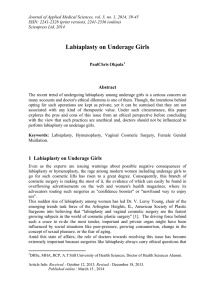63kb
advertisement

The Gender Centre Inc. Fact Sheet Vaginoplasty Techniques Courtesy Benjamin’s Syndrome Information website Reviewed July 1st 2008 Overview Genital Reconstruction Surgery (G.R.S.) corrects the most drastic physical symptom of Benjamin's Syndrome by removing the testicles and constructing a vagina and vulva from the existing genital tissue. The techniques are very sophisticated (though not perfect and not without risk) and a good surgeon can create a result virtually indistinguishable from the natural version. It does not create a uterus or ovaries, so H.R.T. is still desirable after surgery, and there is of course no menstrual cycle. The outcome is essentially equivalent to that for women who have undergone total hysterectomies. G.R.S. is often referred to as Sex Reassignment Surgery (S.R.S.), or sometimes Gender Reassignment Surgery (inappropriately since the surgery doesn't change gender at all) or other variations. Penile Inversion The most common form of G.R.S. is penile inversion. This involves removing the spongy tissue from inside the penis, and inverting the skin. An opening is made between the rectum and the urethra, and lined with the penile skin. Skin grafts can be used to provide additional depth; in recent years, the scrotum has become the preferred source. This requires scrotal electrolysis beforehand to avoid hair inside the vagina – electrolysis around the base of the penis is also highly recommended. Some hair can be removed at the time of surgery, but it helps to get rid of as much as possible beforehand. The remainder of the scrotum is reshaped to form the labia. The urethra is trimmed to the appropriate length, and a clitoris is usually created from the glans of the penis or other sensitive tissue. After the operation, it is necessary to dilate regularly to prevent the new vagina from shrinking. That means inserting a dilator or dildo into the vagina, and holding it in place with steady pressure for an extended period. For the first few weeks several dilations a day are required, but the need diminishes over time to once every few days, or potentially less if sexually active. The vagina does not produce a significant amount of natural lubrication, though fluid may be produced from the urethra during arousal, and some form of lubricant is usually essential for sexual intercourse. Colon Surgery An alternative form of G.R.S. uses a segment of the colon to form the vagina, which has both advantages and disadvantages. The colon segment provides an odourless (if properly cared for), self–lubricating vagina of appropriate dimensions, with little need for dilation to maintain it. The colon segment is rotated within the body, but retains its original blood supply. More external tissue is left from which to form the vulva, requiring less stretching and compromising of nerves and blood supply. Construction of the clitoris is the same as with the penile inversion technique. The main downside is that the surgery is much more invasive than penile inversion. Chopping a piece out of the colon and stitching the loose ends together to close the gap is a bigger shock to the system than surgery restricted to the genital region. Some surgeons use laparoscopic instruments to carry out the operation without having to cut open the abdomen to access the The Gender Centre Inc. Fact Sheet Vaginoplasty Techniques colon, which eliminates scarring but does not greatly reduce the risks. Also, the colon segment produces lubrication constantly, not in response to arousal, and excessive mucus production may be a problem in some cases. Some dilation may be needed to prevent the entrance of the vagina from shrinking. Colon G.R.S. is generally more expensive than penile inversion. Labiaplasty Some surgeons carry out G.R.S. in two stages, a vaginoplasty and a Labiaplasty. Patients of other surgeons may also request a Labiaplasty later to improve the cosmetic or functional result. At the time of the vaginoplasty, the whole genital area becomes very swollen and generally messy. This, along with individual variations in healing, makes it virtually impossible for the surgeon to accurately predict the appearance of the eventual outcome. A more aesthetically pleasing result can be obtained by leaving the finer detailing of the vulva to a later date, after it has healed and the swelling gone down. The two–stage procedure also helps to preserve blood supply and nerve connections, by allowing some to heal before messing around with others. The Labiaplasty typically involves bringing the tops of the labia together and providing hooding to the clitoris, along with refinement of the labia minora. Other problems, most commonly involving the urethra, can also be resolved at the same time. Gender Centre publications provide neither medical nor legal advice. The content of Gender Centre publications, including text, graphics, images, information obtained from other sources, and any material ("Content") contained within these publications are intended for informational and educational purposes only. The Content is not intended to be a substitute for professional medical or legal advice, diagnosis, or treatment. Always seek the advice of your physician or other qualified health care provider with any questions you may have regarding your medical condition. Never disregard professional medical advice or delay seeking it because of something you've read. Always seek professional legal advice on matters concerning the law. Do not rely on unqualified advice nor informational literature. The Gender Centre Inc. 7 Bent Street (P.O. Box 266) Petersham N.S.W. 2049 Ph: (02) 9569 2366 Fax: (02) 9569 1176 Web: www.gendercentre.org.au Email: reception@gendercentre.org.au 2











